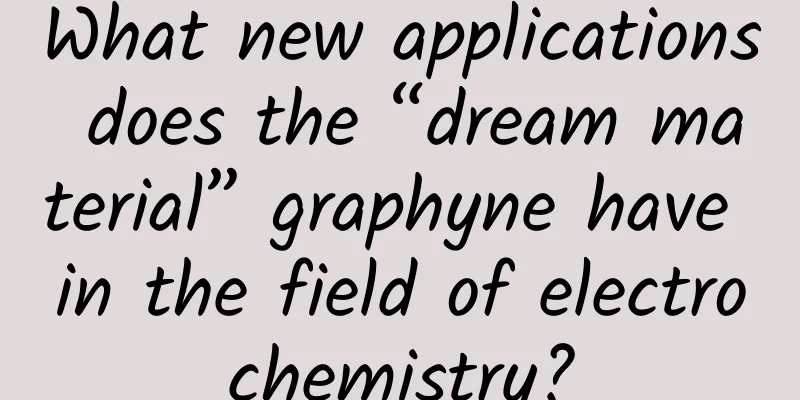What new applications does the “dream material” graphyne have in the field of electrochemistry?

|
Produced by: Science Popularization China Author: Otto Xingguang Produced by: China Science Popularization Expo Energy and environment are two major problems facing mankind, and they are also major issues that need to be urgently addressed. China's timely proposed "dual carbon" goals are an important strategic means to achieve sustainable development, and have been widely recognized and paid attention to by governments around the world. In order to achieve the ambitious goal of "dual carbon", we need to use cleaner energy. How to make good use of new energy? At this time, we need to use two key strategies: electrochemical energy storage and conversion . The application of a new all-carbon material, Graphdiyne (GDY), provides a new perspective and inspiration for traditional solutions. Recently, researchers from the Institute of Chemistry of the Chinese Academy of Sciences also published a review article on the application of graphyne in electrochemical energy storage and conversion. This article introduces us to the unique advantages and research progress of two-dimensional graphyne carbon materials in electrochemical electrode interface applications, and also shows us the specific application scenarios of graphyne. However, before understanding how graphyne is used specifically, let us first talk about what graphyne is. Glynyle is a new type of allotrope formed by carbon element, and is a two-dimensional porous film material after fullerene, carbon nanotubes and graphene. In graphyne, carbon atoms form a π-electron conjugated framework and pores through rich bonding modes of sp and sp2 hybridization, including aromatic bonds, single bonds and triple bonds, which can selectively transmit ions; different bond lengths make it more structurally flexible and make it easier to regulate the environment of the electrochemical interface. As a new type of electrochemical interface material, graphyne exhibits remarkable superiority and compatibility from structure to physical and chemical properties. Figure 1. Application scenarios of graphyne in the fields of energy storage and energy conversion (Image source: Reference [1]) Application of Graphdyne in Electrochemical Energy Storage Electrochemical energy storage plays an important role in promoting the future energy revolution. Representative lithium-ion batteries can be seen everywhere in our daily lives, such as mobile phones, laptops, electric vehicles, etc. Not only are they widely used, but lithium-ion batteries also make our daily lives more economical, efficient and environmentally friendly. However, in the actual application of lithium batteries, there is a problem that restricts the performance of lithium batteries. That is the interface problem. Now the interface problem has also become a common obstacle for the next generation of electrode materials. However, researchers have found that by modifying graphyne and applying it to the battery interface, lithium dendrites can be effectively suppressed, which can improve the life and safety of lithium metal anodes. What magic does the modified graphyne have that can improve the interface problems of batteries? Experiments have shown that graphyne is highly lithium-philic and can improve the kinetics of lithium through the desolvation process, because the pores of graphyne can pass lithium ions without obstacles, but can block solvent molecules. In addition to lithium, graphyne film also has high conductivity and high selectivity for protons, coupled with near-perfect mechanical properties and chemical stability, which also shows the good application prospects of graphyne in the field of fuel cells. Figure 2. Schematic diagram of the desolvation process of lithium ions passing through the pores of graphyne (Image source: Reference [1]) The researchers also combined the growth of graphyne with electrode preparation by first growing or coating active materials on copper foil, then in situ growing graphyne on these active materials and forming a three-dimensional connection network, thereby providing a stable channel for the conduction of ions and electrons and providing strong steric protection for the electrodes. Figure 3. Schematic diagram of the protective interface formed by graphyne (Image source: Reference [1]) Application of Graphdyne in the field of electrochemical energy conversion In addition to electrochemical energy storage, energy conversion is also a necessary means to efficiently utilize energy and reduce pollutant emissions. In terms of energy conversion, graphyne also plays its role. Graphdine has a wide range of application scenarios in the field of electrochemical energy conversion, including oxygen reduction reaction (ORR), oxygen evolution reaction (OER), hydrogen evolution reaction (HER), nitrogen reduction reaction (NRR) and carbon dioxide reduction reaction (CO2RR). Compared with graphene formed by sp2 hybridized carbon atoms, the electrons in the π-conjugated network of graphyne formed by sp and sp2 hybridized carbon atoms are uneven, which has the possibility of generating new active sites. Below we introduce the specific role of graphyne from the two reaction examples of ORR and NRR. The first is the ORR catalytic reaction, which is the fundamental reaction for the next generation of high energy density electrochemical energy technology. Oxygen (O2) is a component of air that we rely on for survival, and oxygen itself is also an oxidant for the combustion reaction of various fuels. In proton exchange membrane fuel cells, oxygen is also a key part. If there is a material that can promote the adsorption of oxygen, it will be beneficial to the ORR catalytic reaction process. In this catalytic reaction process, the addition of modified graphyne can improve the activity of the catalyst. The fundamental reason is that the original nitrogen atom doping in the two-dimensional graphyne can promote the oxygen adsorption and subsequent electron transfer on the active site. In addition, graphyne-based supported single-atom catalysts are also considered to be effective in the ORR reaction process. Figure 4. Schematic diagram of the oxygen reduction reaction (ORR) of nitrogen-doped graphyne (Image source: Reference [1]) In the NRR reaction, graphyne also has its role. Ammonia (NH3) plays an important role in agriculture and energy. Ammonia can be used as an important nitrogen fertilizer and fuel cell fuel. On the other hand, synthetic ammonia is a huge energy-consuming industry. Therefore, the development of new ammonia synthesis methods can show great application prospects in energy conservation and environmental protection. In the NRR reaction, the researchers found that graphyne can indirectly fix ammonia, which in turn helps the subsequent NRR reaction. The specific process is as follows: The researchers found that atomically dispersed zero-valent molybdenum (Mo) atoms can be stably anchored on graphyne, which is attributed to the coordination between transition metal atoms and carbon-carbon triple bonds. Theoretical calculations show that the local charge on the molybdenum atom will be redistributed and become an electron-rich center, while the Mo atom becomes an adsorption site for nitrogen and undergoes subsequent NRR reactions. Figure 5. Schematic diagram of the nitrogen reduction reaction (NRR) of graphyne anchored with molybdenum atoms (Image source: Reference [1]) Summarize In the field of electrochemical energy storage and conversion, graphyne, as a promising emerging material, has achieved some breakthroughs in performance, but is still in the primary research stage. However, scientists are conducting more in-depth and systematic research on existing application areas to further expand the practical application scenarios of graphyne. For example, as a new all-carbon semiconductor with a natural energy band gap, it can be used in electronic devices such as field effect transistors, artificial intelligence devices, wearable devices, and optoelectronic devices. We also expect that in the near future, graphyne will bring us unexpected surprises in different application fields. Editor: Guo Yaxin References: |
>>: Correct understanding of nose bleeding
Recommend
Advertising skills for home furnishing industry
1. Project Introduction A self-installing superma...
Ouch! A mouse is pulling a winter melon!
Audit expert: Li Weiyang Well-known science write...
Where will OPPO go if its differentiated advantage is no longer there?
Among domestic mobile phone manufacturers, OPPO i...
Focus on the defense of small stars! How strong is the "Chinese compound eye"?
On February 14, the second phase of the "Chi...
Online earning sideline project, you will get income if you browse, you can do it all over the world
Online earning sideline project, there is income ...
Not as popular as Lei Jun’s Weibo, many car companies were absent from Chengdu, why are large auto shows no longer popular?
The Chengdu Auto Show opened. As the largest auto...
Is Chen Yizhou a loser?
"Just get half an economy class ticket first...
What should I do if I am a leader for the first time and am responsible for promoting a product?
So how do we implement this comprehensive operati...
Liu Xuan’s personal information: How to improve website weight and master optimization tips?
With the popularization of the Internet, online p...
A guide to avoiding pitfalls when promoting KOLs
Inspired by the recent criticism of traffic fraud...
After spending 5 million, I found out that this is how OCPC, the information flow advertising, works!
Nowadays, many lead-based advertisers are no long...
In search of "Earth 2.0", Chinese scientists propose a sky survey plan
◎ Science and Technology Daily reporter Jin Feng ...
2019 Tik Tok promotion and operation strategy!
20% of the videos account for 80% of the views, b...
Promotion analysis of the hottest marketing campaign!
Behind the popularity of grass-roots marketing is...









